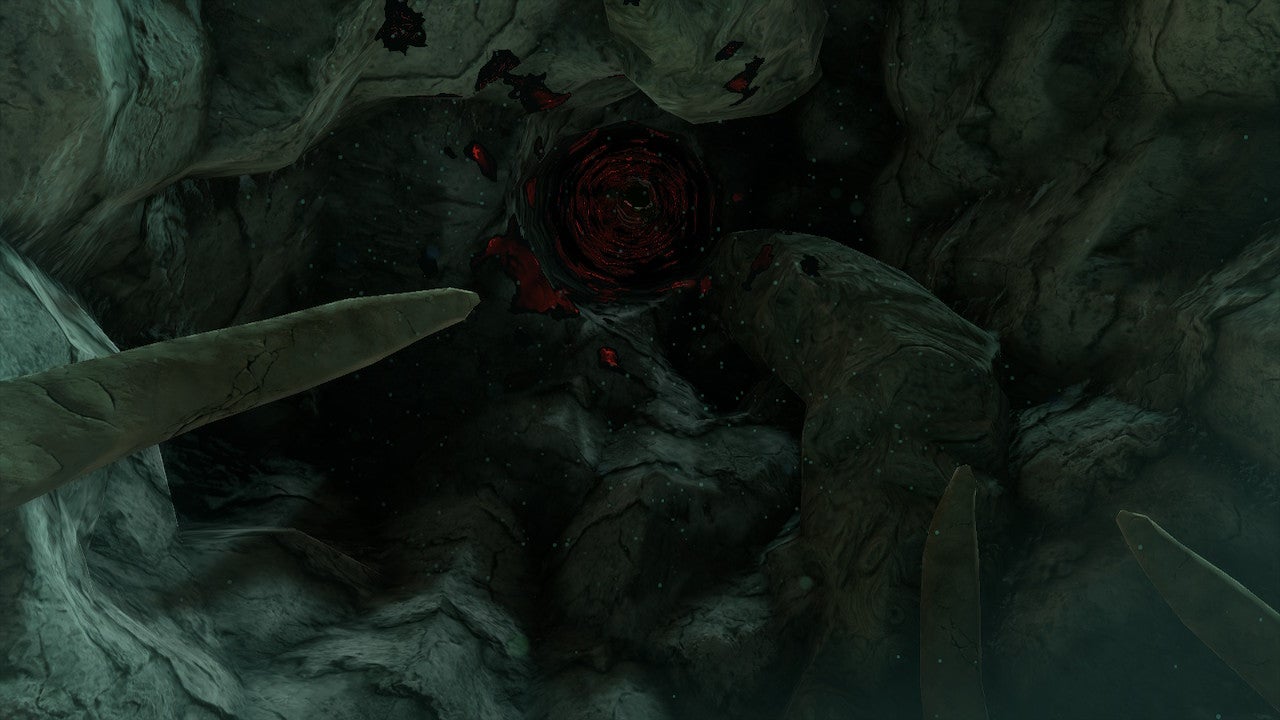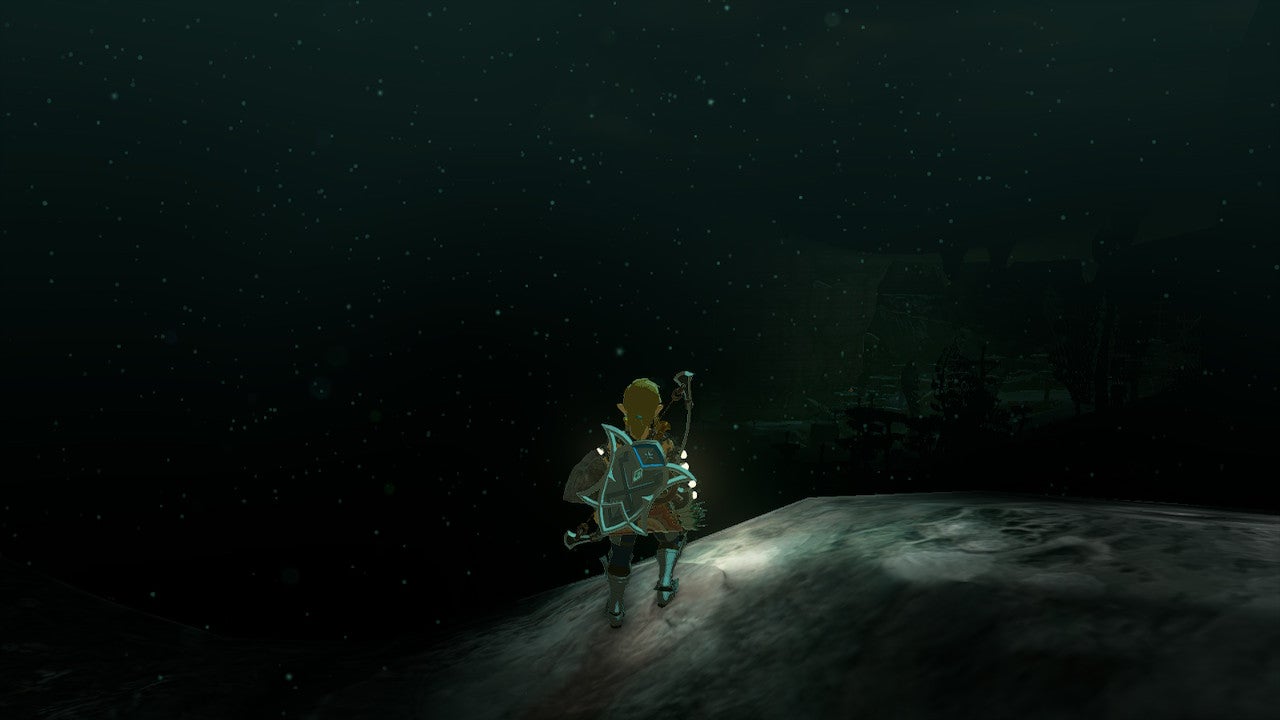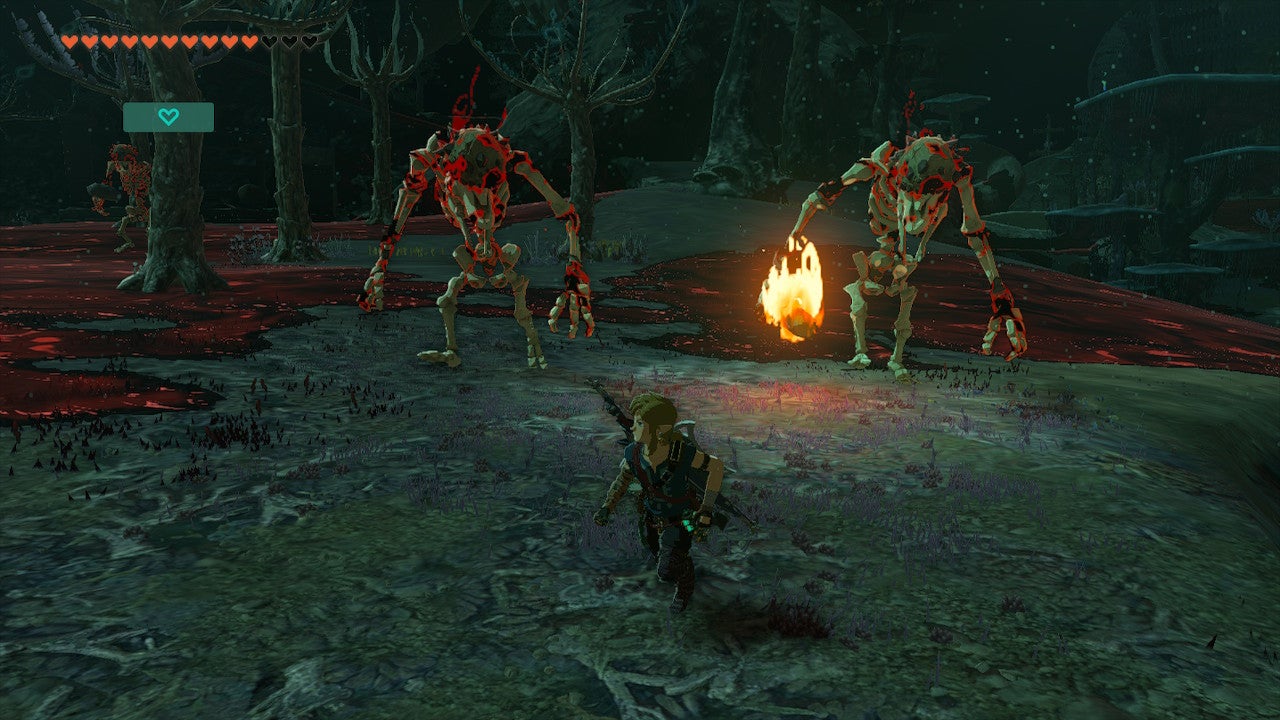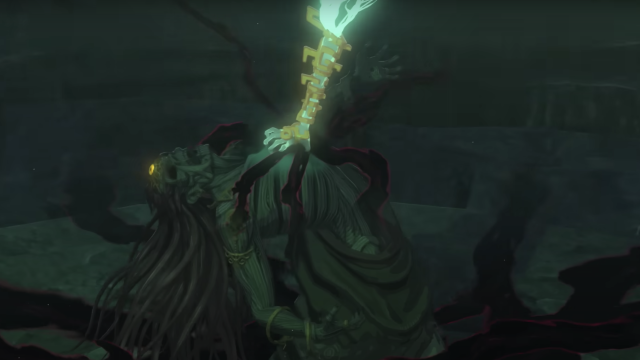Though The Legend of Zelda franchise often dips into the eerie and the occult, its dominant mode is one of high adventure. Rather than associating the Japanese series with horror, we imagine a blonde boy swinging his sword in service of rescuing the princess against a backdrop of soaring music. Its world is populated by oddball NPCs with exaggerated designs, emphasising bulbous facial features or big hair; the denizens of Zelda are cartoons, regardless of what the actual art style is. And it’s those expectations, or the total lack of them, that allows fear to so effectively worm its way into the Zelda games time and time again, constantly catching the player off guard. Tears of the Kingdom in particular blindsides us with the most threatening and unsettling imagery the series has seen for more than a decade. Its source: the Depths.
The game’s very marketing took care to preserve a sense of surprise by largely focusing on Hyrule’s new aerial realm. As misdirection goes, it’s brilliantly subtle; with a lot of floating islands extending the world upward, we hardly expect the game to expand downward, too. Even now, word-of-mouth tends to focus on the elaborate contraptions formed by the new game mechanics rather than tense survival in the dark.
And yet, while playing, it’s difficult to miss the chasm planted at the centre of the map, a geyser of malignant fumes and glowing red Gloom. Even the NPCs warn us to stay away from it, though it’s not long before you jump down and snake deeper and deeper away from the light.

Into Tears of the Kingdom’s Depths
Upon entering the Depths proper, the music blares a discordant bass note to signify that we’ve arrived somewhere entirely new. It is an alien realm, where sickly particles float through the air and plant life comes exclusively in skeletal and fungal varieties. And crucially, it feels as alien as it looks, inverting the mechanics we’ve grown accustomed to in the preceding hours of Tears of the Kingdom, if not the entirety of its predecessor. The original Breath of the Wild template roots itself in the open-world marketing boast of “if you see it, you can go there.” The most distant mountains are climbable, often with some prize or challenge at the top for the trouble of getting there. To navigate Hyrule above is to be constantly and pleasantly sidetracked, driven to explore of our own volition upon spotting a plume of smoke, a Nazca Line-esque imprint on the terrain, a shrine, a cave, a Korok who needs help (assuming help is what you are inclined to offer).
In the Depths, we can still go anywhere but we can no longer see much of anything. Beyond the occasional ring of merciful torches, the darkness is thick and impenetrable without clothing adorned by glowing orbs, a brewed potion, or a brightbloom seed tossed into the distance to provide another small lit area. In the absence of visibility, terrain and the navigation of it become as much of an enemy as the creatures in the dark. The Depths are laden with unseen chasms and the faint red radiation of Gloom that afflicts environment and enemy alike, providing faint warning for the areas that permanently sap our HP until we return to the light. The only thing we can see for sure is an orange lightroot that can be activated to permanently illuminate a large area, yet even these can be obscured by the terrain in between.
Read More: The Best and Worst Parts of Every Zelda Game
In terms of sheer suffocating awe, the Depths most overtly recall the Subnautica games, which strand us in a vast, alien ocean and task us with crafting our way home. The water extends in every direction through multiple biomes, overwhelming because of the sense of space and the prospect of what else might occupy it: leviathan-class predators many times the size of the player roam the world, and because that world is entirely made of water they may come at us from any direction as we delve further below.

As in the Depths, Subnautica’s waters require players to define their own landmarks within a space where it’s easy to get turned around. And like in Zelda, the acute terror does subside with repeated exposure. The rules of survival become apparent, often by learning the hard way: how to proceed carefully, how to avoid a swift and careless death. The Depths are best explored after some preparation, either once we’ve acquired more health to lose or once we’ve stocked up on restorative foods and brightbloom seeds. The monsters tend to congregate in outposts whose lights are visible from far enough away to be given a wide berth.
The exceptions to those rules provide a few fleeting moments of surprise: some particularly large creatures tread beyond the bounds of the outposts and declare their presence with a giant health bar at the top of the screen; the brightbloom seeds are not always permanent, because small frog-like critters waddle through the dark to gobble them up. Even these, however, can be acclimated to: throw a brightbloom seed at a wall or a tree, for example, and the little froggy bastards won’t be able to feed on it.
Zelda and Horror
That Zelda doesn’t sustain the fear of the Depths through the entire game isn’t necessarily a failing. It’s simply how horror works over time. We learn, and we adapt; we find out how to circumvent the problem before us or we become accustomed to it. Perhaps we build a bike in hopes of avoiding the horror altogether, skating over Gloom deposits or blowing past torchlit enemy camps. The intensity, however, remains through the acute memory of the initial encounter. Horror in this vein works precisely because it isn’t all-encompassing, because it isn’t meant to be permanently sustained and remain as effective in the final hours as it was in the first. (Not for nothing are so many traditional horror games rather short, to avoid the dilution of fear that comes with acquiring more powers and tools over time.)
Horror is particularly memorable when it pops up in media that isn’t straightforwardly scary at all, where it comes out of nowhere and goes to work on an audience that has not put up its guard. This style of horror runs not just on the element of surprise but on being enhanced by the unscary material that surrounds it. Some of the most enduring horror images are so effective because of how much they stand out — think, for example, of all the children’s media that bury some image or idea we still remember years after the fact because its intensity so exceeds its wrapper. The boat ride in Willy Wonka and the Chocolate Factory, the surgery massacre in the midst of Spider-Man 2. It extends to more adult films, too — the thing behind the diner in Mulholland Drive, the jittering demons in Jacob’s Ladder. These images benefit from their presence within tense, disorienting material, but they’re so much more impactful because they’re not given much of a spooky preamble.

And although horror is not the first thing we may associate with Zelda, it remains a constant fixture. Even in Tears of the Kingdom, these moments are not confined to the Depths — the Gloom Hands and the Evermean trees leverage our lowered expectations from the picturesque overworld and offer what amount to jump scares. But perhaps the most prominent use of horror in Zelda dates back to the Nintendo 64 games. Ocarina of Time introduces not only the enormous Skulltullas but humans horribly half-transformed into them, their faces and limbs protruding from an arachnid shell. Its Shadow Temple takes place in the remnants of a torture chamber, and its Dead Hand enemy is the sort of grey, blood-stained abomination that you’d find in a much more pervasive horror context.
Majora’s Mask, meanwhile, is famously dark and strange, lending additional power to Ocarina’s muddy images for the bizarre ways it remixes them. For creating an even more prevalent atmosphere of dread, where the apocalypse has its face etched into a slowly plummeting moon. The masks that the entire game revolves around are preceded by close-ups of painful transformation and an accompanying screech of agony. The unsettling qualities of these games persist today, repurposed for the wave of internet-based horror like the creepypasta Ben Drowned and the current movement of indie horror games made to evoke PS1/N64 graphics. The Depths in Tears of the Kingdom offer some of the most effective video game horror in years, and they do it while building on a legacy that’s been hiding in plain sight. Like those damn trees.
Steven is a freelance writer and editor based in the Midwest. He has written for Slant Magazine, Fanbyte, Unwinnable, Polygon, and Buzzfeed News.

Leave a Reply